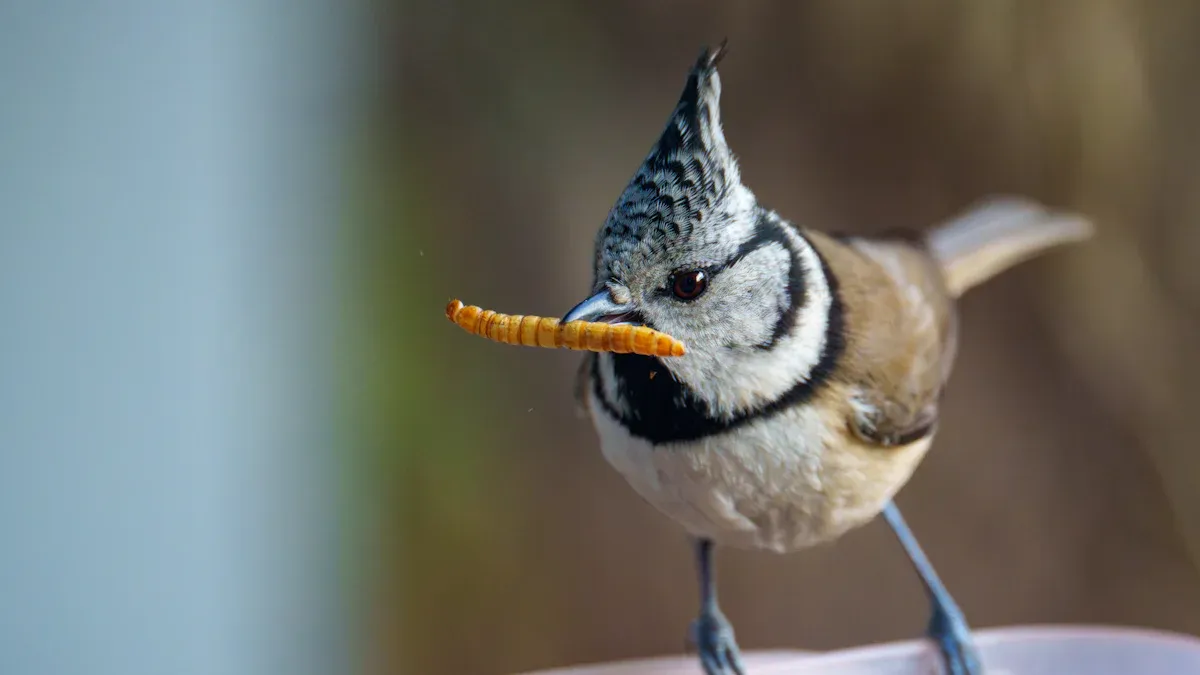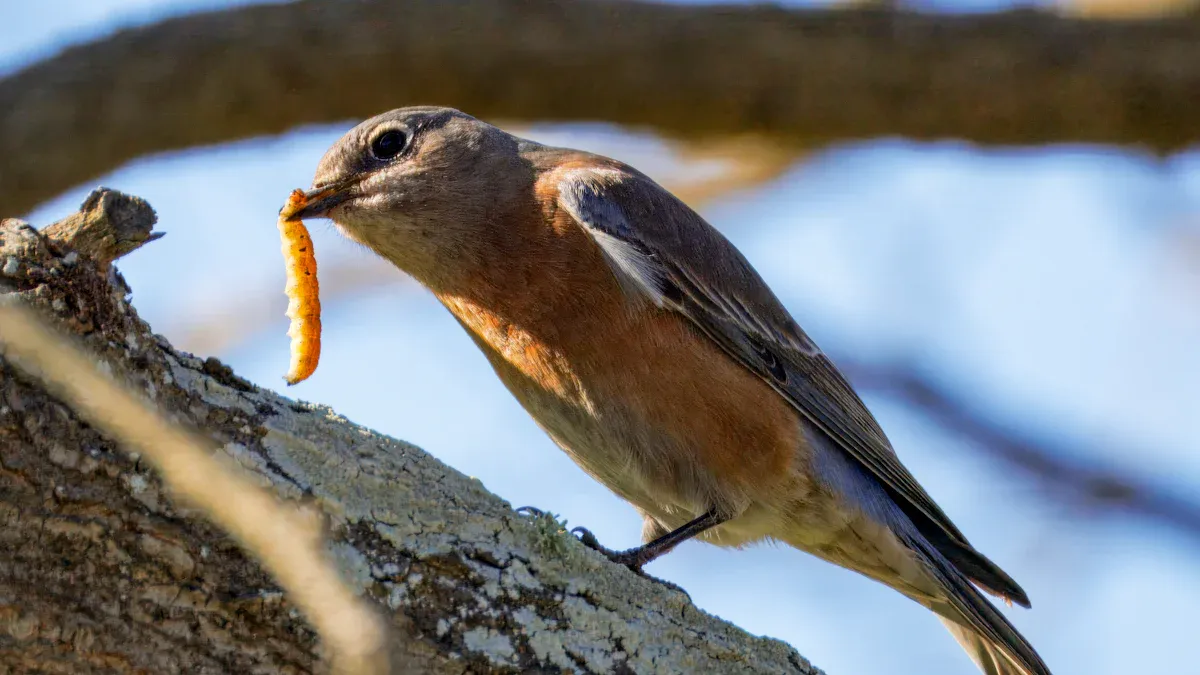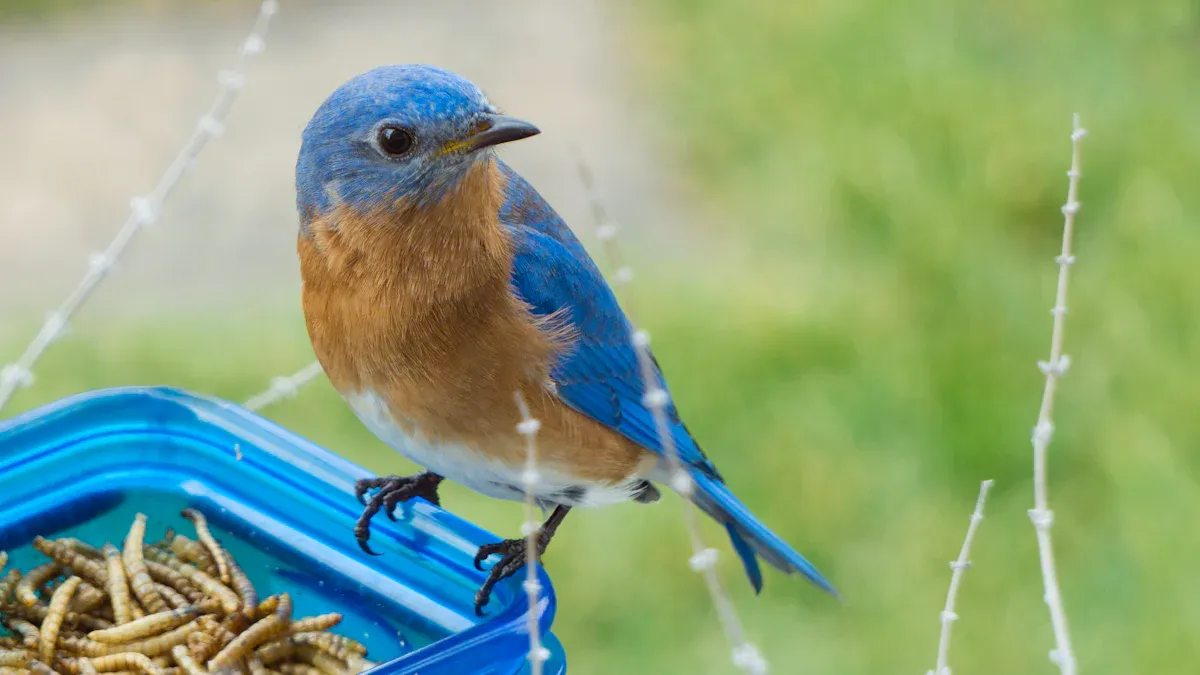
Dried mealworms are a superfood for garden birds. They pack 53% protein and 28% fat, making them an energy powerhouse. Birds digest these nutrients easily, which helps them stay active and healthy. Feeding dried mealworms to birds attracts species like robins and blackbirds, offering birdwatchers a rewarding experience. Their long shelf life means you can use them year-round.
Key Takeaways
- Dried mealworms are full of nutrients for birds. They provide lots of protein and good fats for energy and growth.
- Many bird species love mealworms, making your yard fun for birdwatching all year.
- Soaking dried mealworms before feeding makes them tastier and adds moisture, especially in hot weather.
Nutritional Benefits of Feeding Dried Mealworms to Birds

Protein for Energy and Growth
Protein is the building block of life, and birds need plenty of it to stay active and grow strong. Dried mealworms are packed with protein—studies show they contain between 63% and 71.3%, which is higher than soybean and comparable to fishmeal. This makes them an excellent source of essential amino acids that birds need for energy and growth. Unlike some traditional feeds, dried mealworms offer metabolizable energy and amino acid digestibility that rivals or even surpasses conventional high-protein options like dehulled soybean meal. Feeding dried mealworms to birds ensures they get the nutrients they need to thrive, whether they’re nesting, molting, or preparing for migration.
Healthy Fats for Sustained Energy
Birds burn a lot of energy flying, especially during migration. The healthy fats in dried mealworms help them sustain energy over long periods. Research highlights the importance of omega-6 and omega-3 polyunsaturated fatty acids (PUFAs) in bird diets. These fats improve exercise performance and reduce energy expenditure, which is crucial for migratory birds. By consuming dried mealworms, birds can enhance their flight performance while conserving energy, making these insects a valuable addition to their diet. Whether it’s a robin hopping around your garden or a blackbird preparing for a long journey, the fats in dried mealworms keep them fueled and ready for action.
Vitamins and Minerals for Overall Health
Dried mealworms aren’t just about protein and fats—they also provide essential vitamins and minerals that support bird health. For example, calcium is vital for strong bones and eggshell production. Studies comparing different bird diets show that high-calcium feeds, like those derived from insects, offer significantly better calcium levels than traditional options. Here’s a quick look at how calcium levels stack up across various diets:
| Treatment Group | Mean Calcium % (DM) | Mean Calcium (g/kcal) | Mean Ca:P Ratio |
|---|---|---|---|
| Control (water only) | 0.05%, 0.04%, 0.06% | 0.12, 0.11, 0.15 | 0.07, 0.05, 0.08 |
| Avian hand feeding formula | 0.23%, 0.16%, 0.15% | 0.53, 0.37, 0.36 | 0.30, 0.22, 0.22 |
| Wheat millings diet | 0.05%, 0.05%, 0.05% | 0.13, 0.11, 0.12 | 0.06, 0.06, 0.06 |
| Avian mash diet | 0.22%, 0.12%, 0.22% | 0.50, 0.28, 0.50 | 0.30, 0.18, 0.27 |
| High-calcium cricket feed | 1.02%, 0.70%, 0.78% | 2.42, 1.79, 2.06 | 1.31, 0.97, 1.00 |
Feeding dried mealworms to birds ensures they get a balanced dose of vitamins and minerals, helping them stay healthy and active year-round.
Versatility and Appeal of Dried Mealworms
Attracting a Variety of Bird Species
Dried mealworms are like a magnet for birds. They appeal to a wide range of species, making them a favorite among bird enthusiasts. In one study, researchers placed dried mealworms in a rural area during winter when natural food was scarce. Birds like European robins, great tits, and house sparrows flocked to the feeding site. This shows how dried mealworms can attract birds across different habitats, even during challenging seasons. Whether you live in the countryside or a suburban neighborhood, feeding dried mealworms to birds can turn your yard into a bustling bird haven.
Suitable for Different Feeding Methods
One of the best things about dried mealworms is their versatility. You can offer them in various ways, depending on your setup and the birds you want to attract. Scatter them on the ground for ground-feeding birds like blackbirds. Place them in hanging feeders to draw in species like blue tits. You can even mix them with other bird food to create a balanced meal. Their lightweight and dry texture make them easy to handle, whether you’re filling a feeder or sprinkling them in your garden.
Ideal for Seasonal Feeding Needs
Birds have different dietary preferences throughout the year, and dried mealworms fit right into their seasonal needs. In spring, birds like bluebirds prefer live mealworms as they prepare for nesting. During summer, insects and bugs become their go-to food. As fall arrives, berries take center stage, but dried mealworms remain a reliable energy source. Winter is when dried mealworms truly shine, offering high-calorie nutrition to help birds survive cold nights. Here’s a quick look at seasonal feeding habits:
| Season | Preferred Food | Notes |
|---|---|---|
| Winter | Berries | Larger bluebirds primarily consume berries. |
| Spring | Live feed (mealworms) | Bluebirds switch to live feed as it warms up. |
| Summer | Insects, Bugs | Preference for live insects and larvae. |
| Fall | Berries | Returns to berries as temperatures drop. |
Feeding dried mealworms to birds throughout the year ensures they get the nutrition they need, no matter the season.
Practical Tips for Feeding Dried Mealworms to Birds

Soaking Mealworms for Added Moisture
Birds love dried mealworms, but sometimes they need a little extra hydration. Soaking mealworms in water before offering them can make them more appealing, especially during hot summer days or for birds feeding their young. The added moisture helps birds stay hydrated while still enjoying the nutritional benefits of mealworms. To soak them, simply place the dried mealworms in a bowl of water for about 20-30 minutes. Once they’ve absorbed the water, they’ll plump up and resemble live mealworms, which many birds find irresistible. This small step can make a big difference, especially during dry seasons when water sources are scarce.
Mixing with Other Bird Food
Dried mealworms work wonderfully on their own, but mixing them with other bird food can create a balanced and diverse meal. Combining mealworms with seeds, nuts, or suet pellets can attract a wider variety of birds to your yard. For instance, robins and blackbirds might come for the mealworms, while finches and sparrows enjoy the seeds. Mixing also ensures that birds get a range of nutrients in one feeding session. A simple mix could include a handful of dried mealworms, some sunflower seeds, and a few crushed peanuts. This approach not only enhances the birds’ diet but also makes feeding dried mealworms to birds more exciting for birdwatchers.
Using Appropriate Feeders
Choosing the right feeder is essential for offering dried mealworms effectively. Ground feeders work well for species like blackbirds and thrushes, while hanging feeders are perfect for attracting smaller birds like blue tits and wrens. Some feeders come with small trays or compartments specifically designed for mealworms, preventing them from spilling out. For those who prefer a more natural approach, scattering mealworms on the ground or placing them in shallow bowls can mimic how birds forage in the wild. Studies have shown that birds are more likely to visit feeding stations when mealworms are presented attractively. Here’s a quick look at effective feeding methods:
| Method | Description |
|---|---|
| Training | Birds were trained in groups to monitor individual performance during feeding. |
| Habituation | Birds were habituated to the social feeding system (SFS) stations with ad libitum crumb. |
| Attraction | Mealworms were used to attract birds to the SFS hopper, initially placed in bowls. |
| Monitoring | Feeding was monitored via CCTV and by weighing food bowls and hoppers. |
By using the right feeder and method, bird enthusiasts can ensure that their feathered visitors enjoy a safe and satisfying meal.
Potential Drawbacks and Precautions
Avoid Overfeeding to Prevent Dependency
Feeding birds dried mealworms is rewarding, but overfeeding can lead to dependency. Birds may start relying on this easy food source instead of foraging naturally. This could disrupt their natural feeding habits and reduce their ability to find food in the wild. Offering mealworms in moderation ensures birds still practice their foraging skills. A good rule of thumb is to provide small amounts at a time, just enough for a quick snack. This way, birds benefit from the nutrition without becoming overly reliant on your feeders.
Importance of High-Quality Mealworms
Not all dried mealworms are created equal. High-quality mealworms meet strict nutritional standards set by organizations like the Association of American Feed Control Officials (AAFCO) and the European Pet Food Industry Nutritional Guidelines (FEDIAF). These standards ensure the mealworms provide the right balance of protein, fats, and amino acids for birds. Choosing premium mealworms reduces the risk of contamination and ensures birds receive the best possible nutrition. Always check the packaging for certifications or quality seals before purchasing.
Monitoring for Pests and Other Risks
Feeding dried mealworms comes with a few risks if not handled properly. Contamination from Salmonella or other pathogens can occur during production. The substrate used to rear mealworms may also introduce microbial hazards. To minimize these risks, store mealworms in a cool, dry place and use airtight containers to keep pests away. Additionally, soaking mealworms before feeding can prevent dehydration in smaller birds. Regularly cleaning feeders and monitoring for signs of pests ensures a safe feeding environment for your feathered visitors.
Feeding dried mealworms to birds offers a safe and nutritious way to support their health while attracting them to your yard. These mealworms provide essential nutrients like protein, fat, and vitamins, boosting survival rates for songbirds and enhancing their immune systems. By soaking mealworms for hydration or mixing them with other foods, bird enthusiasts can maximize their benefits. Whether you’re new to bird feeding or a seasoned pro, dried mealworms are a convenient choice for year-round feeding.
FAQ
What types of birds eat dried mealworms?
Many insect-eating birds love dried mealworms. Common visitors include robins, blackbirds, blue tits, and wrens. They’re a favorite treat for both small and large species.
How should dried mealworms be stored?
Store them in a cool, dry place. Use an airtight container to keep them fresh and prevent pests. Proper storage ensures a longer shelf life.
Tip: Keep mealworms away from direct sunlight to maintain their quality.
Can dried mealworms be fed year-round?
Yes! Dried mealworms are suitable for all seasons. They provide extra energy in winter and essential nutrients during nesting and migration periods.


